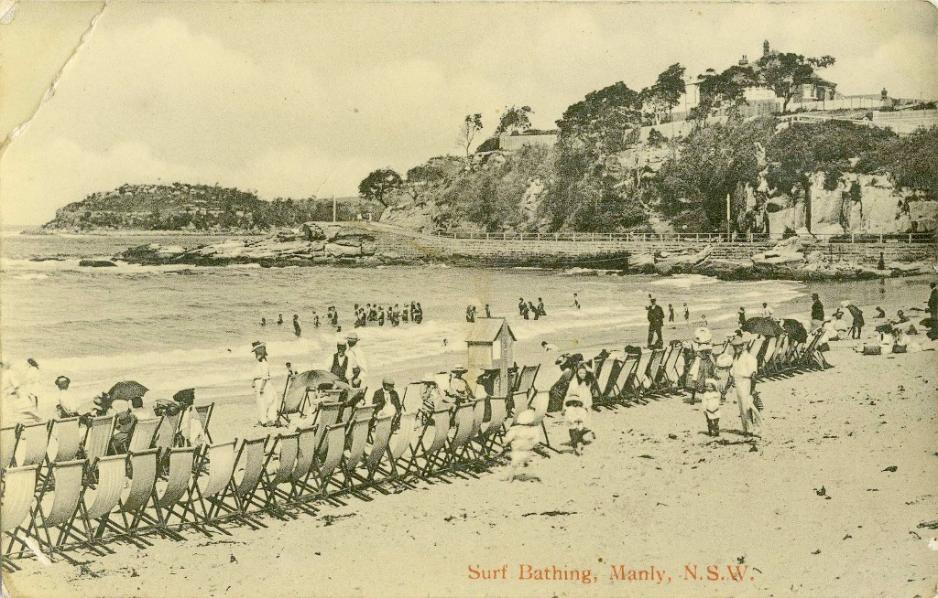September 8 - 14, 2013: Issue 127
Surf Bathing in Australia and the Advent of ‘Swim Between the Flags’
We owe our love of surfing and swimming, or ‘surf-bathing’ as it was originally called, to our indigenous custodians. Taking to the water in droves, or saving newly arrived settlers who could not swim but would venture out in boats, has been reported as early as 1791. In this instance it was the famous Bennelong who swam with his kin to save those deposited in the water from an overturned boat.
In the 18 February 1834 edition of the Sydney Gazette announced that ‘bathing is now the favoured recreation in Sydney’.
Bathing is now the favourite recreation in Sydney. The ladies are provided for by Mrs. Bigges's accommodations, while every part-of the banks, both of Darling Harbour and round the Government Domain, is, morning after morning, thronged with the other sex. AUSTRALIA Sydney Gazette. (1834, February 18). The Sydney Gazette and New South Wales Advertiser (NSW : 1803 - 1842), p. 2. Retrieved from http://nla.gov.au/nla.news-article2215434
This form of washing yourself, despite ‘bathing houses’ existing, as well as cooling off, did not prevent fatalities:
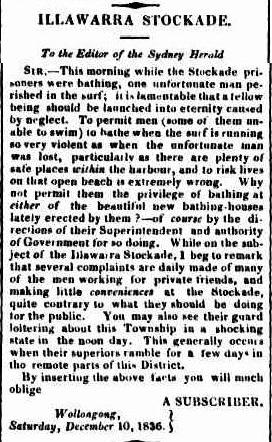 Right: ILLAWARRA STOCKADE. (1836, December 19). The Sydney Herald (NSW :
1831 - 1842), p. 2 Supplement: Supplement to the Sydney Herald. Retrieved from
http://nla.gov.au/nla.news-article12855649
Right: ILLAWARRA STOCKADE. (1836, December 19). The Sydney Herald (NSW :
1831 - 1842), p. 2 Supplement: Supplement to the Sydney Herald. Retrieved from
http://nla.gov.au/nla.news-article12855649
Four years later, in the name of decency, a ban on daylight swimming was imposed (6am to 7pm) although people outside the city central areas most certainly continued to bathe at will. As recorded in Surf bathing lifesaving and Manlys First Surf carnival- 1907 by early newspapers, this right to swim in daylight was challenged in 1902 when two young men who had been arrested were champion by Manly resident Mr Gocher and by 1903 more people snubbed their noses at this ‘law’. It was just too darned hot not to get in the sea. This did not stop the fines for ‘exposure’ and the fines did not stop the swimmers;
SURF BATHING. Another young man has been heavily fined for exposure at Manly. SURF BATHING. (1905, February 7). The Gundagai Times and Tumut, Adelong and Murrumbidgee District Advertiser (NSW : 1868 - 1931), p. 2. Retrieved from http://nla.gov.au/nla.news-article125735549
FIRST OF OUR BEACH MARTYRS SUFFERED IN 1893. Bathers Have Long Waged Battle Against the Killjoys and Self -Appointed Censors One Time it Was Illegal to Bathe in Daylight Australia Still Far Behind Overseas Countries in Seaside Liberty. THE first martyr in the great fight for surfing freedom paid the penalty of his faith way back in 1893. Since those days numberless unknown martyrs have suffered in the cause, victims of the outraged morality of official and self appointed censors. But year by year the sun-cult has increased the number of its devotees. And year by year the irksome restrictions have disappeared though many of the strangest of them remain on the statute books.
A couple of summers ago, the beaches began to look brighter and more color-splashed than ever before, and surfers began to acquire atleast some of the freedom enjoyed by kindred spirits in England, the United States and on the fashionable Continental beaches. But 'this freedom' was too good to last. The spectacle of young folks looking happy and athletic always annoys some people, and the result was that censors began to descend on the beaches. Already in Sydney beach inspectors have been busy. And in this State this week regulations, copied from those of Sydney, were expected to be introduced shortly to control beach wear. Modern bathers are almost invariably beautiful, trim fitting and PERFECTLY DECENT And many of those who would sec evil in them would experience a quiver of righteous horror even in the sight of a woman- wearing one of the old CIRCUS TENT CONTRAPTIONS that once passed for a bathing suit. Practically all will pass the regulation test.
On January 7, 1893, James Lawler, aged 49, a humble laborer looked at the water and saw it was good. Three days later, the daily press reported:
WATER POLICE COURT: At this court on Saturday, James Lawler (49), was fined 20’ with the alternative of a month's imprisonment, for bathing at 6 o'clock the previous evening. James Lawler was not committing an offence against public morality by bathing. His offence against public morality was that he entered the water during daylight hour's — between (5 a.m. and 8 p.m. That was against the law, in those days. Back in the dim. dark, dirty days of long ago. James Lawler was thus enrolled among the earliest martyrs of beach-control. The years have suddenly slipped by to 1902. Times have changed. Lots of people go surfing now, hundreds of them. Men,
of course, not women. Councils began to sit up and take notice — through, binoculars. And one of the newspapers commented thus: 'Under the Towns and Police Act, the authorities may at any time prosecute any person bathing after 6 a.m. or before 8p.m., no matter in what form they are dressed. In deference to public clamor, this HARSH AND ABSURD CLAUSE is not just now being enforced at recognised bathing sites. What is required to suppress the bad conduct of the minority is a severe penalty for a breach of suitable costume regulation . . . .'
The fine, under Clause 78 of the Police Offences Act, was £10. IT happened on November 13. 1902.
BATHERS AT BONDI INTERFERENCE BY THE POLICE INDIGNANT RESIDENTS'
Yesterday many bathers who enjoy a dip in the ocean at Bondi were surprised to find two police officers patrolling the beach, and warning people that all found in the water after o'clock, no matter how they were clothed, would be prosecuted under the provisions of an obsolete law. For a time a number of disappointed visitors unwillingly obeyed the mandate, but later on they proceeded to bathe. As a result the two constables set to work and collected 30 or 40 names. On the morning of November 14, scores of bathers turned up at Bondi in full force, including a Reverend gentleman, determined to fight for their rights, but no police appeared. The police had reported that 'so Ion:: as bathers wore suitable costumes and public decency was not outraged, the way could not be seen to taking action.' And so people won the right to swim in the public view by daylight. But Mother Grundy (you must hand it to her) is a fighter. Now for the first time we begin to read of women in the surf. Yes, WOMEN! Sanctity of the home, future mothers, feminine modesty, Queen Victoria — all these, not withstanding — it gradually became known that some, or should we say, certain women, were taking up the practice of surfing!At first they bathed far away from the men, and. as much as possible, at different times. But there were one or two BATHING FATALITIES and, as a newspaper of the day relates: 'For better safety women bathers have gradually moved over towards the men's area for protection.' That started mixed bathing. What shocking abuses came out of that state of affairs is seen in the great fight which the decent section of the community had to put up in defence of public morality, in January, 1908.That month a Council clerk, writing to the Inspector of Police, made, among other things, this significant statement:
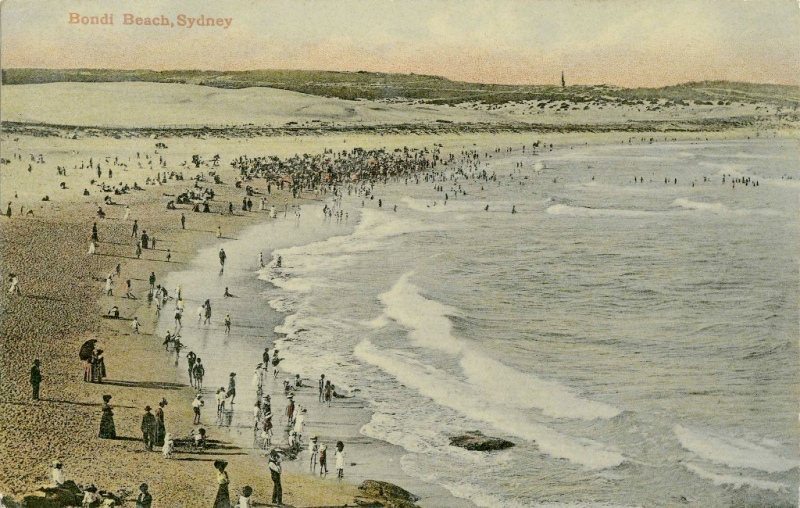
Bondi Beach, circa 1908. Charles Kerry image courtesy State Library of NSW
'Only one instance is known where men crossed the road in bathing costume, wearing a coat. They were not seen by the police.''Only one instance,' but it revealed in what direction, owing to official laxity, things were likely to go unless firm steps were taken. The full glare of public attention being now directed upon the beaches what the public saw there shocked the entire decent community. It was terrible, so terrible that thousands of decent citizens at last saw clear before them the path of duty —to give up their Sundays and go and look at the shocking things that were going on on the beach and in the water. This is what they saw, as described by one eminently-reputable observer who was present on the beach on January' 20, 1908: 'Probably the most objectionable item was the dress — or want of dress. Very few of the men were clothed FROM 'NECK TO KNEE'
With the girls, the majority had apparently only one flimsy garment on, which clung closely to the figure, and left little mystery as to the shape of the form or limbs it covered.' And when it is said that of these scanty coverings many were much torn, it will be understood that more was disclosed than prudery would prompt. 'Depravity could sink no deeper.
That very week new ordinances were rushed into operation. 'The new ordinances,' one official explained, 'will fully cope with the objectionable features. They set out that the costume should cover the body from neck to knee'. ~ The trunks, in my opinion, should be worn inside the dress either that or a singlet — and knickers should be worn. For women, I think that a short skirt is the most becoming costume.
Still surf-bathing continued to grow in popularity. In January, 1913, Australia's first surf pageant was held — at Manly — and the publicity included a big drawn heading of a lady (neck-to-knee plus) emerging from a wave. But even then, male and female sunbathe IN SEPARATE ENCLOSURES and husband and wife could not lunch together in costume. But the day of the Canadian two piece costume was coming- a sort of drowning-made-easy outfit that used to get up round your neck. THEN came the one-piece, the back starting to creep down, the legs to creep up, bright colors to creep in, and sudden artistic gaps to appear. THEN came trunks for men And brassiere tops for women, but they didn't come far, because THEN came the killjoys again. FIRST OF OUR BEACH MARTYRS SUFFERED IN 1893. (1935, October 26). Mirror (Perth, WA : 1921 - 1956), p. 21. Retrieved from http://nla.gov.au/nla.news-article75717836
Flags being used for safety is first recorded in the newspapers of the day as being in 1903 at Manly
The subject of surf bathing was brought up by a letter from the local Life Saving Society, to whom the council had offered flags for defining the positions of dangerous holes and treacherous bathing places. The society preferred that the council should put the flags up. It was decided to ask the Premier to supply Manly with a surf boat and gear. MANLY. (1903, March 25). The Sydney Morning Herald (NSW : 1842 - 1954), p. 8. Retrieved from http://nla.gov.au/nla.news-article145642
And with the thousands that streamed to the ocean, it became necessary to not only formalise that men were putting themselves son the line voluntarily but also that they needed support from officialdom:
SURF BATHING. There was a meeting of executive officers of surf bathing clubs and life saving societies last night at the Sports Club. Mr. F. W.J. Donovan (the president of the Manly Surf Club) was voted to the chair, and Mr. L. C. Ormsby (Bondi Surf Bathers' Life-saving Club) was elected Hon. secretary pro tem. It was decided on tho motion of Mr. M. A. Roberts (Manly Surf Club) and Mr. G. H. Henriques,-"That It Is desirable to form an association of surf clubs, to secure Improved facilities for surf bathing, and otherwise promote and regulate the sport." Also, on the motion o£ Mr. A. W. Relph (Manly Surf Club),and Mr. James Clark (Bondi Surf Club),"That the association be called 'The Surf Bathing Association of N.S.W." This was agreed to. And on the motion of Mr. F. A. Thorpe and Mr. M'Laughlin,-"That the hon. secretary write to the Minister for Works informing him of the formation of the association, and asking for a consultation In regard to the ordinances." A resolution was also carried thanking the press for its splendid support against the proposed ordinances and costumes. SURF BATHING. (1907, October 19). The Sydney Morning Herald (NSW : 1842 - 1954), p. 17. Retrieved from http://nla.gov.au/nla.news-article14906184
SURF LIFE-SAVING. HISTORY OF THE MOVEMENT Great Humane Organisation.
Describing the work of the surf lifesaving clubs and tracing the history of the movement from the formation of the first, club in 1903, copies of an attractively illustrated pamphlet reprinted from the 'New Nation' magazine, have been received by the honorary secretary of the West Australian State Centre (Mr. E.M. Scott) from the Surf Life-saving Association of Australia. The pamphlet includes a picture of Western Australia’s champion surfer, Jack Hampshire, who is described as 'a typical Australian beltman.' Open sea rescue and resuscitation during the last 28 years, it is pointed out, has been responsible for the saving of 29 640 lives. During this period no lives have been lost while the patrols have been on duty.' The history of surf life-saving in Australia forms a narrative of heroic accomplishment and steady progress' .states the pamphlet. 'In conjunction with the great summer recreation of surf bathing, the movement has steadily developed until it is now spread throughout the Commonwealth and ranks among the greatest voluntary humane organisations of the world. During the surf bathing season, which usually extends from October to April, the beaches are regularly patrolled at week-ends and on holidays by club members. A strict watch is kept on the bathers and grave danger is often faced in effecting the rescue of persons in difficulty.. There is no material reward for the work. The voluntary spirit in which it was inaugurated has been preserved and this is the feature that has placed the work on the high plane it occupies today. It was not until 1902 that bathing on the ocean beaches became general. As the crowds on the various beaches increased, risks became greater. The problem of how to render proper assistance to bathers in distress inevitably arose. First, the practice of joining hands and forming a living chain was tried, but with little success. Boats were then engaged on some beaches but rough seas frequently made this method of rescue ineffective. Later, thick coir ropes, to which heavy belts were attached were installed in a box on many of the beaches but they were much too cumbersome and formed convincing proof that new methods and transportable equipment were necessary for effective surf work. Necessity for efficient organisation brought about the first of the surf life-saving clubs.
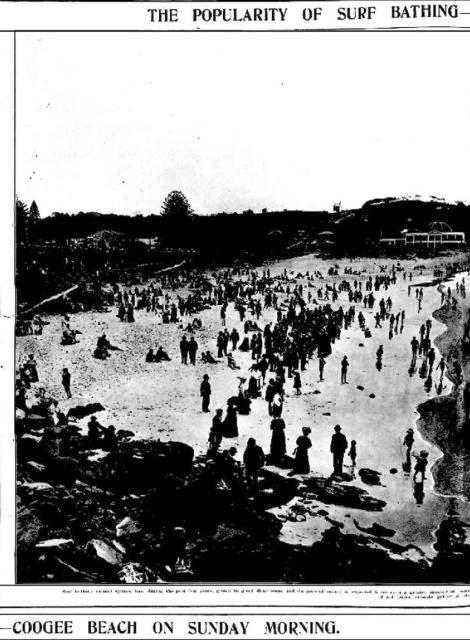 The First
Club. (Coggee Beach, From Australian Town and Country Journal, Wednesday 30
October, page 30, 31)
The First
Club. (Coggee Beach, From Australian Town and Country Journal, Wednesday 30
October, page 30, 31)
The first club to be formed was Bronte, in 1903, when a small band of interested bathers met and decided to form a lifesaving club or 'surf club* as it was then termed. The efforts of these young men were immediately successful. One of the factors in the success of their rescues was an improvised reel to which a line and a large kapok belt were attached. The first reel was designed by John Bond, a staff sergeant of the Medical Staff Corps, but a much improved model was later made by a Paddington coachbuilder. Although the belt served its purpose as a means of buoyancy for the rescuer and patient, it proved in many instances an encumbrance to the progress of the rescuers. Subsequent experiments resulted in the adoption of a much lighter belt. Following the success of the Bronte Club similar clubs were formed on other beaches near Sydney and their efforts provided the public with a means of safety and confidence in surf bathing. The efforts of these pioneers met with great success but it was evident that still better results would be achieved with united action and standardised methods of working. For this purpose a meeting of executive officers of surf bathing and life-saving clubs was convened and held at the Sydney Sports Club on October 18, 1907, when It was resolved to form an association to be known as The Surf Bathing Association of N.S.W. Regulation methods and gear were adopted in 1908 and in October of the following year a surf proficiency test for members was decided upon. On March4, 1910 (incidentally, the year in which the movement was established in Western Australia) the association decided to award a bronze medallion to those members who had attained the required standard of efficiency in rescue and resuscitation methods, reel and line work and a knowledge of physiology.* Public Interest Aroused.
The following year marked a new era in the association's activities as it was during this year that, after further exhaustive tests, reel line and belt were standardised. Although since improved, the main principles are still in operation. The organisation was now rapidly gaining membership and the standardisation of gear made it possible to arrange interclub competitions which were the means of exciting public interest and earning general recognition of the movement. The methods became so well known and surf bathing Increased in such popularity as the feeling' of safety grew among the population that it was necessary to form more and more life-saving clubs. As the demand increased there was no lack of enthusiastic and willing young swimmers to nil up the required quota to patrol all the beaches used by the public The success achieved in New South Wales was noted by visitors and the movement extended' to the other States. Visitors from overseas also took a keen interest in the movement. Reels, boats, and other life-saving gear have been sent all over the world, and the handbook of the Surf Life-Saving Association Is used as the official manual for the work. Branches are now operating in Queensland, Western Australia and Tasmania, while there are affiliated associations and clubs in South Australia, New Zealand, Holland, South Africa, India, Ceylon, Egypt and Palestine.'
JACK HAMPSHIRE. From a photograph reproduced in a pamphlet issued by the Surf Life Saving Association of Australia in which he is described as 'a typical Australian beltman.' SURF LIFE-SAVING. (1936, February 6). The West Australian(Perth, WA : 1879 - 1954), p. 9. Retrieved from http://nla.gov.au/nla.news-article32989231
SURF BATHING. Mr. Joe Gardiner writes: — As one of the earliest of that indefatigable band of enthusiasts who have done so much to popularise that most 'healthful and exhilarating of pastimes, surf-bathing, I beg to protest most strongly against the action of an inflated Bumbledom on the hunt for a little cheap notoriety. Surf bathing has come to stay, and nothing that the alder-maniacs can do will prevent it. Medical 'knowledge and practical experience of the benefits derived are all on the side of the surf bather, and the sun bath devotee. That, there may be abuses in the matter of costumes by some extremists is at once admitted; but 'why owing to the bad taste exhibited by an in- ?finitely small percentage of surf bathers should the great and growing army of daily dippers in the briny be penalised? There are some things that can be killed by ridicule, and this 'absurd mixture of ci Incline and Turkish highwayman costume is one of them. Had the whole matter been remitted for suggestion and report to the various surf clubs, I feel sure that an amicable and satisfactory arrangement in the matter of bathing dress would have been arrived at. Lord Nelson used to say he had always been a quarter of an hour before his time, and it had made a man of him. It would seem that the average Mayor of a waterside resort is a thousand years behind his time. 'If this agitation results in nothing else than driving a wholesome lesson home to those who think because they have a little brief authority they can take some share in the direction of the universe, it will not have been in vain. Meanwhile the decorous surf bather goes on his way enjoying to the full his daily battle with old Father Neptune, and entirely oblivious of the puny efforts of those who would seek to clothe him in a garb that would be a cross between the clothes of a new woman and a glorified ballet dancer.
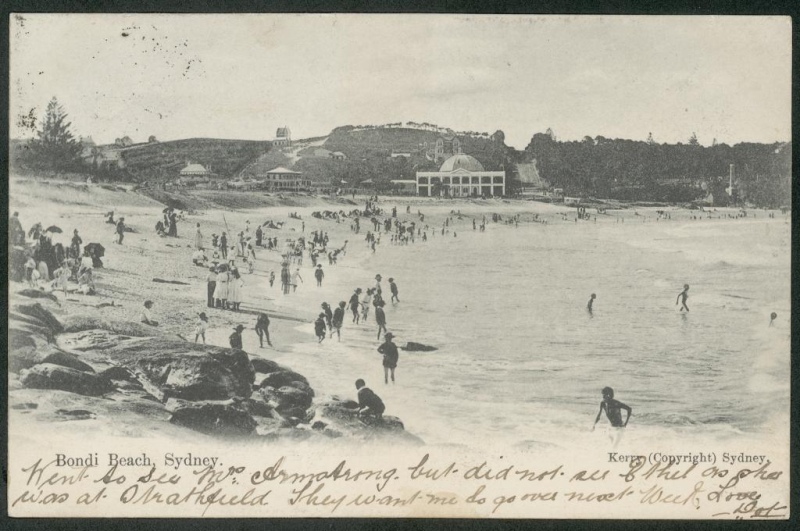
Bondi Beach, 1906, Charles Kerry image Courtesy State Library of NSW.
One swimmer writes: — Although as unprecedented outburst of public reprobation and ridicule has practically squelched the skirt costume proposal, there is another almost equally ridiculous proviso which may slip through, and become law, unless blocked in good time. This will be found in the portion referring to 'enclosed baths,' and seeks to prohibit bathers from smoking therein. The idea of proposing to limit a bather's stay in a bathing enclosure was silly enough; but this proposal, to prevent him enjoying a smoke, can only be described as the very acme of official foolishness. Mr. H. M'Laughlin writes: — Re some remarks of mine at the recent inaugural meeting of the Surf Bathing Association, wherein I referred to the assistance given to the sport by the Mayors of Randwick and Waverley. I-un not profess, as you say, to put in a ward for the Mayor of Waverley,' as. in my opinion, his and the Waverley Council's work speaks for itself. I merely wished to disabuse the minds of the meeting on this point. With regard to Coogee Beach, I also acknowledged the assistance given by the local Mayor, although I criticised as absurd the proposed ordinance regarding 'sun hatching' in macintoshes. The opposition to surf bathing at Coogee originally displayed by the Randwick Council, I understand, was before it was shown (which many doubted) that the beach could safely be made use of for surf bathing. SURF BATHING. (1907, October 22). Evening News (Sydney, NSW : 1869 - 1931), p. 2. Retrieved from http://nla.gov.au/nla.news-article113894724
SURF BATHING. 'One Who Knows' writes pointing out the good work done at. Bronte by Mr. W. V. H. Biddel in developing the sport of surf bathing: He-concludes: — 'It is resourceful, practical men of this stamp who can render invaluable service in the humanitarian work of life-saving in connection with the increasingly popular pastime of surf bathing, and it is because of this I have taken the pains to make myself thoroughly conversant with the efforts and achievements of this indefatigable pioneer of surf bathing and life saving, who so far seems to get little or no credit. SURF BATHING. (1908, October 21). Evening News (Sydney, NSW : 1869 - 1931), p. 3. Retrieved from http://nla.gov.au/nla.news-article113771755
SURF BATHING. 'A Modest Surfite' writes:— 'One Who Knows' writes to say that the indefatigable pioneer of surf bathing. Mr. W. V. B. Bidell, gets little or no credit for his work, on behalf of the sport. Surely this is not the case? Everyone who knows anything about surf bathing knows all about Mr. Bidell. and the torpedo belt, and the albatross, and everything else at Bronte, including the large club of which Mr. Bidell is the president. I am sure Mr. Bidell does not seek notoriety of this kind, and 'One Who Knows' surely is not closely acquainted with, Mr. Bidell, or he would not have written such a letter. SURF BATHING. (1908, October 22). Evening News (Sydney, NSW : 1869 - 1931), p. 8. Retrieved from http://nla.gov.au/nla.news-article113774150
Flags from this earliest date were a part of any surf life saving club and the slogan ‘swim between the flags’ has become part of our language and like all safety equipment, developed as our knowledge of achieving a high level of safety has:
TEN HINTS FOR SAFETYIN THE SEA . The following ten hints to bathers who find themselves in difficulties were given today by Mr. L. P. Gadsden, general secretary of the Surf Life Saving Association, W.A. Head centre: —(1) Float on the back. (2) Elevate an arm as a signal that you are in difficulties.(3) Don't panic; this uses energy.(4) Don't attempt to cross a current.(5) When a rescuer appears, keep calm, he knows his job. Don't cling to him.(6) Do exactly what you are told. The patrol man is trained in initial tests for membership, up to a minimum distance of 200 yards.(7) Don't over-estimate your ability in the sea. If you can swim 100yards, keep within this distance.(8) Don't go in areas marked 'danger.' This is courting trouble. (9)- Obey- warning' signals given by Life Savers. Swim between the flags.(10) Finally, never interfere with lifesaving equipment. You may require it. TEN HINTS FOR SAFETY IN THE SEA. (1933, November 13).The Daily News (Perth, WA : 1882 - 1950), p. 1 Edition: LATE CITY. Retrieved from http://nla.gov.au/nla.news-article84999668
Powers Of Beach Inspectors . Council beach inspectors in New South Wales and four honorary beach inspectors from each surf club have power to order surfers from the water or" sections of it. The president of the Surf Life Saving Association of Australia, Judge Curlewis, said this last night. He said the Local Government Act in New South Wales gave this power. He heartily supported an attempt by the Mayor of Coolangatta, Alderman L. Peak, to have similar legislation introduced in Queensland. Alderman Peate said he would ask the Queensland Government to introduce legislation giving lifesavers power to order people from beaches and out of the water when the surf was dangerous.
AVOID DELAYS. Judge Curlewis said: "I am pressing the authorities in New South Wales to grant the powers to all patrol captains. "This would short-circuit any delays that might occur in emergency situations. "The beach inspectors can order people to surf between the flags. They can also close the beach by crossing the flags. "If people refuse to obey the inspectors, they can report to the local council, which has power to prosecute. "The penalty is a maximum fine of £10." Judge Curlewis said beach inspectors found 99 per cent, of the public most co-operative. The powers were necessary to deal with the 1 per cent, who insisted on knowing more than lifesavers.
When these people got into difficulties by bathing outside the flags or refusing to leave the water when it was dangerous, lifesavers risked their lives to rescue them. Powers Of Beach Inspectors. (1948, December 29). The Sydney Morning Herald (NSW : 1842 - 1954), p. 6. Retrieved from http://nla.gov.au/nla.news-article18103932
SURF WARNING CHANGE MADE The National Council of Surf Lifesaving yesterday decided on a different method of notifying the public that a beach is unsafe for bathing. In the past safety flags were crossed when the beach inspector considered the surf unsafe. From next season, a sign-post worded "Beach closed Surf dangerous" will be placed prominently on the beach. The Surf Life Saving Association's publicity officer, Mr.J. B. Dillon, said last night that many surfers did not realise a beach was closed when the flags were crossed. "As a result some dived into the ' surf before they could be warned," he said. "The notice will clear up this confusion and will assist in making surfing safer. "Every club in Australia will receive a notice-board before next season." SURF WARNING CHANGE MADE. (1953, March 16). The Sydney Morning Herald (NSW : 1842 - 1954), p. 5. Retrieved from http://nla.gov.au/nla.news-article18361844
